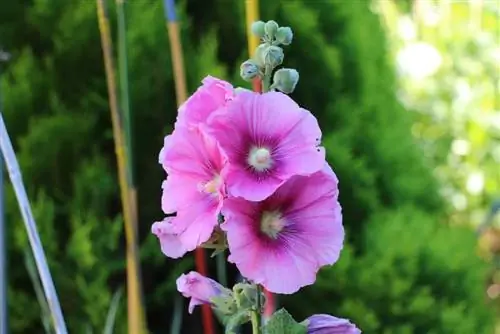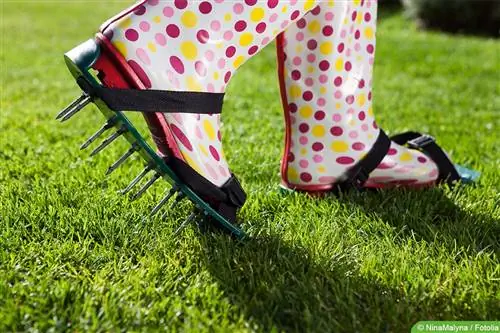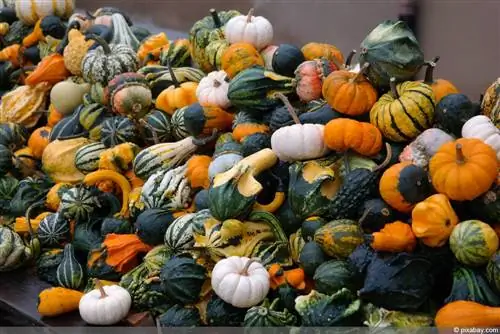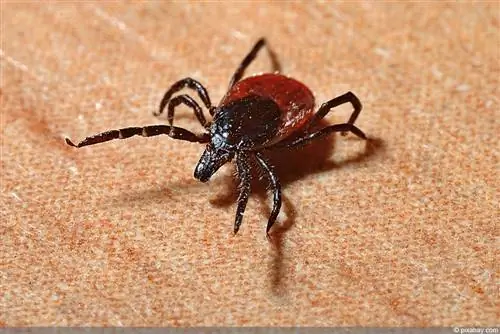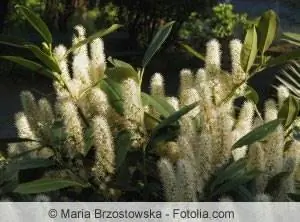- Author admin [email protected].
- Public 2023-12-17 03:39.
- Last modified 2025-06-01 06:48.
With the hollyhocks (Alcea Rosea), we are bringing a stunningly beautiful plant from the mallow family into our gardens. With their wide color spectrum, the towering inflorescences offer an impressive parade in all shades, ranging from black and red to violet and apricot. The long-lasting plants are also ideal as cut flowers. But when and how should hollyhocks be cut? Here we give you helpful tips on how to properly cultivate these bright beauties.
Pruning after flowering
As with most perennials, the recommendation for the unusually beautiful mallow plants is: you can cut them, but you don't have to. As a rule, cutting serves to maintain he alth and stimulate flower growth. However, hollyhocks are a special case in the group of perennials. Most of the mallow family are biennial, meaning they are in full force for two growing seasons. The first period is immediately after sowing or planting the young plants in the garden, then comes winter and is followed by the second growing season, after which most of these plants die. Pruning immediately after flowering in the first year definitely stimulates growth because the hollyhock doesn't have to use any energy to produce fully ripe seeds. It can retreat into the ground early and will produce abundant flower growth in the second growth phase. If you cut after the second flowering phase, there is a high probability that the plant will sprout again next year. This is particularly true for the unfilled hollyhocks, which can bloom again in the third period. If the location is optimally chosen, the gardener has a good chance of enjoying the towering beauties even in the third summer.
- cut the plants at a height of 10 to 12 cm from the ground
- Pruning immediately after flowering limits uncontrolled growth through self-propagation
Variety selection is crucial
A special case of hollyhocks are the hybrid varieties, for example the varieties Parkrondell, Parkfrieden and Parkallee, which were bred from Alcea rosea and Althea officinalis. They are clearly perennial varieties where pruning after flowering results in vigorous, he althy growth. There is no need to fear that the plants could be damaged by pruning; on the contrary, the beautiful mallow plants thank you for this attention with increased flower growth in the coming year. These varieties have also proven to be extremely robust and resistant to occasional mallow rust, making them preferred by many gardeners.
- Hollyhocks are excellent, long-lasting cut flowers for tall vases
- be sure to use a sharp knife or sharp rose scissors, do not crush the stems
Tip:
For the vase, all Alcea varieties should be cut early in the morning, preferably in cool weather, and under no circumstances at midday. Score the stems crosswise so that they can absorb enough water. Check the water daily and change it completely every two to three days.
Prune late after flowering

If you prefer two-year-old hollyhocks, you will certainly have some particularly beautiful varieties, such as Alcea rosea nigra, which blooms deep, dark red, almost black. With this variety, as with other biennials, the gardener will be happy to grow the unusual beauties for longer than two years. In this case, the hollyhocks should not be cut immediately after flowering. You can then calmly form germinable seeds, which are collected to grow new young plants. The seeds usually have the same properties as the mother plant. With this late cut, the plant is still able to recharge its batteries for the new flowering season during the resting phase, but it may well be that flowering is limited to two vegetation phases.
- don’t cut too low to the ground
- only collect and sow ripe seeds
- be sure to use sharp tools, blunt scissors will crush the stems
Tip:
Young plants can easily be grown from the seeds. They can be grown early in the cultivation pot on the windowsill. They can also be sown directly on site, but care must be taken to maintain a planting distance of around 50 cm. Do not place more than 3 hollyhocks close together as tuff. Remove excess plants and possibly replant them elsewhere.
Cutting when affected by disease
If you notice early in the year that mallow rust has struck, you should definitely prune. This is a fungal disease that occurs frequently and must be combated immediately. Mallow rust becomes apparent as early as spring with the appearance of dark spots on the upper side of the leaves; white pustules appear on the underside, which can later turn brown. In this case, immediately cut off all affected leaves and dispose of them in the trash. In many cases, the plants will still develop numerous flowers, so pruning can be done after flowering. However, care must be taken to ensure that the disease does not spread to other plants, which is why affected areas must be removed immediately.
- Never place plants close together
- Never throw removed leaves into the compost, from there the rust will spread again
Avoid cutting altogether?
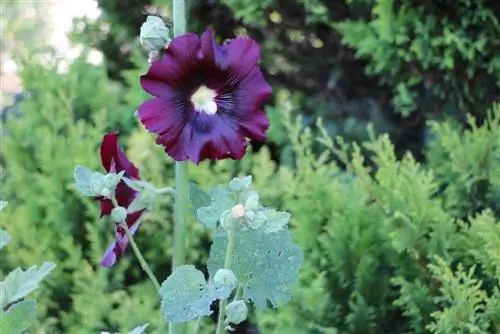
Since perennial plants do not necessarily need to be cut, it is entirely possible to forego pruning. However, this measure should be taken for two reasons. On the one hand it is good for the plant, on the other hand it is also a question of appearance. Precisely because the long inflorescences are so conspicuous and faded flowers are a very unsightly sight, it is a good idea to cut back the flowered stems. However, if you didn't prune in the fall and decide to do so at short notice, you can still prune very early in the spring. However, this will only have a negligible effect on the abundance of flowers.
Recommended varieties
Perennial
- Parkallee, delicate creamy yellow with purple stamens, flowers July - October
- Parkrondell, clear pink, semi-double, flowers June - September
- Parkfrieden, old pink, semi-double, flowers June - September
- Happy light, large, different colored flowers, 150 cm, flowering July - September
Two-year-olds
- Mars Magic, bright red, unfilled, flowers June - September
- Peniflora white, densely filled, approx. 180 cm, flowers June - September
- Polarstern, white with bright yellow center, unfilled, flowers June - September
- Alcea rosea nigra, black-red, unfilled, bee pasture, 220 cm, flowers June - September
- Alcea ficifolia, available in red, pink and yellow, approx. 170 cm, flowers June - September
Conclusion
If you want to do something good for your hollyhocks, you should prune them after they bloom. The only question that arises is whether the plants should be strengthened for the next growth phase, or whether you want to obtain seeds from particularly beautiful varieties so that you can continue to cultivate them in the garden in the coming years. Pruning immediately after flowering always ensures an enormous abundance of flowers and he althy plants. Pruning early also ensures that the tall-growing beauties do not multiply uncontrollably. Although cutting is not absolutely necessary, it should not be avoided, especially with hollyhocks.

